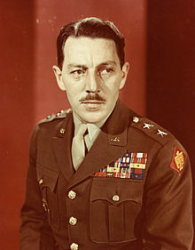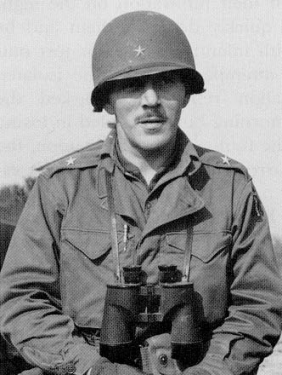
 |
|
|
||
|
Robert Tryon Frederick |
||||
|
Graduate, U.S. Military Academy, Class of 1928 Engagements: • World War II (1941 - 1945) |
||||
| Biography: | ||||
|
Robert Tryon Frederick Robert Tryon Frederick was born on 14 March 1907 in San Francisco, CA. When he was 14 years old, he lied about his age to join a Cavalry unit in the California National Guard. He attended Staunton Military Academy from 1923-24 and the U.S. Military Academy from 1924-28. Upon graduation from West Point, he was commissioned as a Second Lieutenant in the Coast Artillery. He graduated from the Command and General Staff School at Fort Leavenworth, KS, in 1939. In 1942, as a staff officer serving in the War Department, then-Lieutenant Colonel Frederick was tasked with raising the joint U.S.-Canadian force which became the 1st Special Service Force. The unit, activated on 9 July 1942 at Fort William Henry Harrison, MT, was originally intended for commando operations in Norway, and trained extensively in winter and mountain warfare, as well as hand-to-hand combat and other infantry skills. In April 1943, the unit moved to Vermont for training, first at Camp Bradford and then at Fort Ethan Allen. However, the Norway mission was canceled and the 1st Special Service Force was sent instead to the Aleutian Islands in July 1943. It returned to the continental U.S. in September, and then left in October for the European Theater of Operations. Frederick's men arrived in Casablanca in French Morocco in November 1943 and quickly moved to the Italian front. Landing at Naples on 19 November 1943, the 1st Special Service Force went into the line. In December 1943 and January 1944, the 1st Special Service Force conducted a series of operations at Monte la Difensa, Monte la Remetanea, Monte Sammucro (Hill 720) and Monte Vischiataro. Frederick was promoted to Brigadier General in January 1944. After the 1st Special Service Force (or Devil's Brigade) attacked and captured the enemy forces at the impregnable Monte la Difensa, the victory prompted Winston Churchill to declare that Robert Frederick was "the greatest fighting general of all time" and "if we had had a dozen more like him we would have smashed Hitler in 1942." On 2 February 1944, Frederick's men landed at Anzio and went into action along the Mussolini Canal. They were the first Allied troops to enter Rome on 4 June 1944. For valor with the 1st Special Service Force in Italy, Brigadier General Frederick was twice decorated with the Distinguished Service Cross, the U.S. Army's second highest award for valor. The first award was for actions on 10-13 January 1944 and the second for actions on 4 June 1944. While at Anzio he was wounded a number of times, including two separate wounds on a single day. On 23 June 1944, Frederick announced he was leaving the unit. He was to be promoted to Major General and given command of an ad hoc division-sized airborne formation, the 1st Airborne Task Force, for the invasion of Southern France (Operation Dragoon). The task force, formed that July, consisted of the British 2nd Independent Parachute Brigade and the U.S. 509th Parachute Infantry Battalion, 517th Parachute Regimental Combat Team, 550th Glider Infantry Battalion, 551st Parachute Infantry Battalion and 460th and 463rd Parachute Field Artillery Battalions, along with various support units. Under the code name Rugby Force, the unit jumped on 15 August 1944 into the Argens Valley between Le Luc and Le Muy, behind the Massif des Maures, a key piece of terrain which overlooking the Allied landing beaches near St. Tropez and St. Raphaël. Having successfully blocked German forces from reaching the invasion beaches, the 1st Airborne Task Force linked up with the 36th Infantry Division on 17 August 1944. It then moved up the French Riviera coastline, taking Cannes unopposed on 24 August and linking up with Frederick's old unit, the 1st Special Service Force. The 1st Special Service Force had initially been tasked to seize several small islands off the French Riviera and then moved onshore, where it was attached to the 1st Airborne Task Force on 22 August (replacing the British 2nd Independent Parachute Brigade). The task force then fought on to the French-Italian border, where it took up defensive positions. The task force was dissolved on 23 November 1944 and the 1st Special Service Force was disbanded on 5 December. Major General Frederick was given command of the 45th Infantry Division in December 1944, and led the Division through the end of the war. The 45th saw heavy combat in French Alsace from December 1944 through February 1945, and was pulled from the line to rehabilitate on 17 February. In mid-March, it was assigned to XV Corps for the drive into Germany. The Division crossed the Rhine and advanced to the Main. Moving along the Main into Bavaria, the Division participated in heavy fighting in Aschaffenburg from 28 March to 3 April and then drove to Nuremberg, taken in heavy fighting from 16-20 April. Moving south, the Division crossed the Danube on 26 April, and opened up the path for the 20th Armored Division to drive on Munich. Reaching Munich on 29 April, the 45th Division shifted from combat to occupation. After a period of occupation duty, the 45th Infantry Division prepared to return to the U.S. and Major General Frederick relinquished command in September 1945. After a period of staff duty and recuperation (he had been wounded eight times), Major General Frederick was assigned to Allied occupation forces in Austria, commanding the U.S. Sector of the Vienna Inter-Allied Command in 1948. From 28 February 1949 to 10 October 1950, Major General Frederick commanded the 4th Infantry Division, which had been reactivated as a training division at Fort Ord, CA, in 1947. In October 1950, the Division was re-designated the 6th Infantry Division and Major General Frederick continued as its Commanding General until 1951. Major General Frederick returned to Europe in 1951 to take command of the Joint U.S. Military Aid Group, Greece (JUSMAG Greece). MG Frederick retired from the Army on disability in March 1952. Medals and Awards Distinguished Service Cross with Bronze Oak Leaf Cluster Foreign Awards Legion of Honor in the grade of Officer (France) Distinguished Service Cross Citation (1st Award) The President of the United States of America takes pleasure in presenting the Distinguished Service Cross to Brigadier General Robert Tryon Frederick (ASN: 0-17196), United States Army, for extraordinary heroism in connection with military operations against an armed enemy as Commander of the 1st Special Service Force, in action against enemy forces during the period 10 January to 13 January 1944, near Mount Vischiataro, Italy. While commanding his own organization and an attached task force, Brigadier General Frederick made a personal reconnaissance to determine hostile positions prior to an attack. Far in advance of the foremost elements of his command, under enemy machine gun, mortar and artillery fire, he probed enemy defenses and selected a covered route of approach for his troops. While leading his men against the enemy, he continued his reconnaissance in advance of his forward troops to obtain information from which to plan the development of the attack. Operating in terrain almost devoid of cover and concealment, he organized a surprise attack that quickly drove the enemy from a strategically important position. Brigadier General Frederick's constant presence under enemy fire forward of his own troops proved an inspiration to them and a decisive factor in the accomplishment of his mission. His heroism, aggressiveness, and tactical skill exemplify the highest traditions of the military forces of the United States and reflect great credit upon himself, his unit, and the United States Army. General Orders: Headquarters, Fifth U.S. Army, General Orders No. 102 (1944) Distinguished Service Cross Citation (2nd Award) The President of the United States of America takes pleasure in presenting a Bronze Oak Leaf Cluster in lieu of a Second Award of the Distinguished Service Cross to Major General Robert Tryon Frederick (ASN: 0-17196), United States Army, for extraordinary heroism in connection with military operations against an armed enemy as Commander of the 1st Special Service Force, in action against enemy forces on 4 June 1944, in Rome, Italy. In order to advance to the city of Rome and seize bridges within the city, General Frederick organized a small, fast-moving force of armored vehicles and infantry to speedily execute the mission. Upon entering the city, the force met strong, determined resistance. Because of communication difficulties, General Frederick moved from place to place, constantly under fire, issuing orders and controlling his units. When the resistance had been overcome and movement through the city resumed, General Frederick, with only a small party, sped ahead in his half-track vehicle to examine the bridges for demolitions and neutralize charges that may have been placed but not yet exploded. As the examination of the first bridge was completed, an enemy unit approached to cross. In the ensuing fight, five of the enemy were killed, six wounded, eleven captured, and the remainder forced to withdraw. Although General Frederick had been slightly wounded early in the day and twice wounded at the bridge, he spent the remainder of the night disposing his forces to protect the bridges. His courage, leadership and determination in battle inspired his troops and were largely responsible for the successful accomplishment of a difficult operation. Major General Frederick's gallant leadership, personal bravery and zealous devotion to duty exemplify the highest traditions of the military forces of the United States and reflect great credit upon himself, his unit, and the United States Army. General Orders: Headquarters, Seventh U.S. Army, General Orders No. 22 (January 28,1945) Honors In the 1967 film, The Devil's Brigade, which chronicled the formation, training and combat in Italy of the 1st Special Service Force, Robert T. Frederick was played by actor William Holden. V-42 Combat Knife The V-42 combat knife was designed in part by the Commanding Officer of the Devil's Brigade, Lt. Colonel Robert T. Frederick. This knife was the trademark weapon of the Devil's Brigade, and its members were trained extensively in the use of this knife. The profile of this knife is the one pictured on the crest of the US Army Special Forces and Canada's JTF2. It is a short-bladed stiletto with a thumb groove on the top of the blade to promote proper hand placement when attacking an opponent and is often confused with the longer- and thicker-bladed Fairbairn-Sykes fighting knife. Death and Burial Major General Robert Tryon Frederick died on 29 November 1970 in Stanford, CA. He is buried at the San Francisco National Cemetery in San Francisco, CA. His wife, Ruth Adelaide Fredericks, died on 25 June 1972 and is buried beside her husband. |
||||
| Honoree ID: 2518 | Created by: MHOH | |||
Ribbons
Medals
Badges
Honoree Photos
 |  |  |
 |  |
 |


